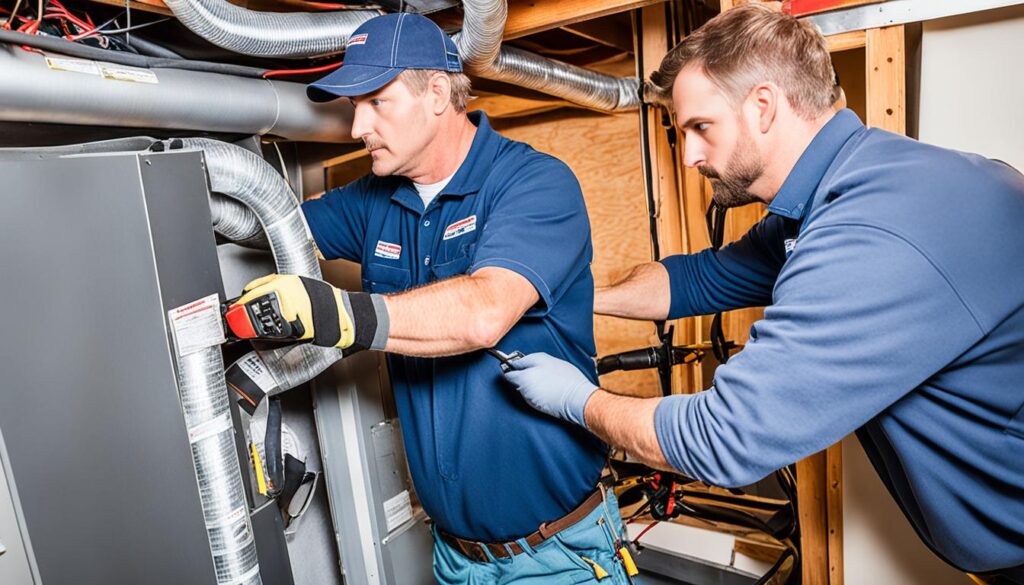Are you considering installing a furnace in your home? Knowing the steps involved can help you navigate the process with confidence and ensure a successful installation. From furnace assembly to venting and testing, each step plays a crucial role in setting up a functional and efficient heating system.
In this comprehensive guide, we will walk you through the complete furnace installation process, providing detailed instructions and valuable tips along the way. Whether you’re a seasoned DIY enthusiast or a homeowner looking to understand the process better, this article will equip you with the knowledge you need to install a furnace correctly.
Key Takeaways:
- Installing a furnace requires a series of steps for proper functionality, safety, and efficiency.
- Understanding furnace installation requirements is essential before starting the installation process.
- Proper preparation and determining the location contribute to a successful furnace installation.
- Following each step of the installation process, including assembly and testing, is crucial for a functional furnace.
- Ensuring safe operation and regular maintenance are essential for the longevity and efficiency of your furnace.
Understanding Furnace Installation Requirements
Before installing a furnace, it is essential to understand the specific requirements involved. This includes conducting a load calculation of your home to determine the appropriate furnace size.
Load calculation is a crucial step in the HVAC design requirements for any furnace installation. It considers factors such as the size of your home, insulation levels, and climate to determine the heating capacity needed. By accurately calculating the load, you can ensure that the furnace is neither too powerful nor too weak for your home’s heating needs.
Another important requirement is ensuring proper ductwork sizing. It is essential to have the right size of ducts for optimal airflow and efficient heating distribution throughout your home. Incorrect ductwork sizing can lead to reduced comfort and energy inefficiency. Professional HVAC technicians can help determine the correct duct size for your particular furnace installation.
During the installation process, gas and electrical connections must be checked and installed correctly. These connections play a vital role in the safe and efficient operation of your furnace. Hiring a licensed HVAC professional to handle the gas and electrical connections is recommended to ensure compliance with local codes and regulations.
Furthermore, compatibility with existing equipment should be assessed. If you have an existing HVAC system or other heating components, compatibility is paramount for seamless integration and proper functioning. A qualified technician can evaluate compatibility and recommend any necessary modifications or upgrades.
By meeting these furnace installation requirements, you can ensure a successful and efficient heating system that meets your home’s specific needs.
Preparing for the Installation
Before the furnace installation process begins, proper preparation is crucial to ensure a smooth and successful experience. This involves various steps, including meeting with a sales representative, taking accurate measurements, and considering any necessary structural alterations.
Meeting with a sales representative is an essential part of the preparation process. The representative will discuss your heating needs and provide recommendations based on a thorough load calculation. By understanding your specific requirements, they can guide you towards the most suitable furnace options for your home.
In addition to discussing your heating needs, the sales representative will also assess your home’s current infrastructure. This assessment includes evaluating the ductwork, gas lines, and electrical wiring to determine if any modifications or alterations are necessary for the installation. Properly sizing the ductwork and ensuring compatible gas and electrical connections are vital for the furnace’s optimal performance.
Accurate measurements are another crucial aspect of preparing for furnace installation. Your sales representative may take measurements of your home to determine the appropriate furnace size and ensure proper fit and functionality. This step is important to avoid any issues or inefficiencies that may arise from an incorrectly sized unit.
If structural alterations are deemed necessary during the assessment, your sales representative can provide guidance on the best course of action. This may involve making changes to accommodate the new furnace, such as adjusting ventilation systems or installing additional supports. By addressing these alterations before the installation, you can prevent any delays or complications that may arise during the process.
In conclusion, adequate preparation is key to ensure a successful furnace installation. By meeting with a sales representative, taking accurate measurements, and considering any necessary structural alterations, you can set the stage for a smooth and efficient installation process. Taking these steps will ultimately contribute to the longevity and performance of your new furnace.
Determining the Location for Your New Furnace
Choosing the right location for your new furnace is crucial for its proper functioning and longevity. When determining the location, there are several factors to consider to ensure optimal performance. These factors include furnace location, furnace placement, accessibility, and clearance requirements.
Furnace Location: Start by assessing the available space in your home. Consider areas where the furnace can be installed without obstructing walkways or doorways. The furnace should be placed in a central location to provide even distribution of heat throughout the house.
Furnace Placement: Ensure that the furnace is easily accessible for installation and future maintenance. The location should allow HVAC technicians to reach the furnace easily for repairs or inspections. It should also be situated in an area where noise from the furnace operation will not be disruptive.
Accessibility: The furnace location should have adequate space around it for easy access. This includes having enough clearance space from walls, floors, and other objects. Proper accessibility ensures that technicians can perform necessary maintenance and repairs without any hindrances.
Clearance Requirements: Safety is a top priority when it comes to furnace installation. It is essential to adhere to clearance requirements to prevent any hazards. Consult local building codes and manufacturer guidelines to determine the necessary clearance space for the specific furnace model you are installing.
By carefully considering these factors, you can determine the ideal location for your new furnace. This will optimize its efficiency and effectiveness, providing you with reliable heating for years to come.
What Are the Steps of Installing a Furnace?
Now that you have prepared for the installation and determined the location, it’s time to start the installation process. Follow these steps to ensure a successful furnace installation.
- Furnace Assembly: Begin by assembling the furnace according to the manufacturer’s instructions. This may involve attaching components, such as the blower motor, heat exchanger, and control board. Refer to the provided diagram or manual for proper assembly.
- Electrical and Gas Connections: Once the furnace is assembled, make sure to connect the electrical wiring and gas supply. Follow the manufacturer’s guidelines for proper wiring and gas pipe installation. Be sure to turn off the gas supply before making any connections and ensure all connections are securely tightened.
- Venting: Proper venting is crucial for safe operation of the furnace. Install the vent pipe according to local building codes and the manufacturer’s instructions. Ensure that the vent pipe is properly sealed and free from any obstructions that could impede airflow.
- Testing: Before completing the installation, it’s essential to test the furnace to ensure it is functioning correctly. Turn on the power and gas supply, then run the furnace through a heating cycle. Check for any abnormal noises, smells, or malfunctions. If everything appears to be in working order, proceed with the final steps of the installation process.
By following these steps, you can confidently complete the installation of your furnace and ensure its proper functionality. If you encounter any difficulties or have concerns during the installation process, consult with a professional HVAC technician for guidance and assistance.
Ensuring Safe Operation
Safety is paramount when it comes to operating a furnace in your home. By implementing key safety measures, you can minimize risks and enjoy peace of mind. These measures include:
- Proper Ventilation: adequate ventilation is essential to prevent carbon monoxide buildup, a dangerous gas that can be emitted by the combustion process. Make sure your furnace is installed in a well-ventilated area to allow for the safe expulsion of combustion byproducts.
- Regular Maintenance: to keep your furnace running efficiently and safely, regular maintenance is crucial. This includes tasks such as cleaning or replacing air filters, inspecting and cleaning the system’s components, and ensuring all connections are secure. Adhering to a maintenance schedule will help prevent potential issues and extend the lifespan of your furnace.
- Regular Inspections: periodic inspections by a qualified professional are essential to detect any hidden issues or potential hazards. A trained technician can identify and address problems that may compromise the safety and performance of your furnace. Schedule regular inspections to ensure optimal operation and identify any necessary repairs or replacements.
By prioritizing furnace safety through proper ventilation, regular maintenance, and regular inspections, you can ensure the safe and reliable operation of your heating system. Remember, a well-maintained and properly functioning furnace not only provides comfort but also ensures the well-being of you and your loved ones.
Maintenance Tips for Your New Furnace
Regular maintenance is essential for ensuring the longevity and efficiency of your new furnace. By following these maintenance tips and guidelines, you can maximize the lifespan and performance of your furnace:
- Regular filter replacement: Replace the furnace filters every 1-3 months, or as recommended by the manufacturer. This ensures optimal air quality and prevents dust and debris from clogging the system.
- Duct cleaning: Schedule professional duct cleaning every 3-5 years to remove accumulated dirt, dust, and allergens from the ductwork. This helps maintain proper airflow and improves indoor air quality.
- Thermostat programming: Set your thermostat to energy-saving temperatures when you’re away from home or sleeping, and optimize the settings for comfort during active hours. This helps reduce energy consumption and lowers utility bills.
- Professional servicing: Regularly schedule professional maintenance visits for your furnace. A certified technician can inspect and clean the system, identify any potential issues, and ensure optimal performance. Professional servicing also helps maintain the validity of your warranty.
By following these maintenance practices, you can keep your new furnace running smoothly and efficiently, saving energy and avoiding costly repairs in the long run.
Conclusion
Installing a furnace is a meticulous process that necessitates careful planning, adherence to specific requirements, and following a step-by-step approach. By fully understanding these steps and prioritizing safety and maintenance, homeowners can enjoy the perks of a dependable and energy-efficient heating system in their homes. Consultation with professionals is crucial for installation and maintenance needs, and safety should always be the top priority.
Throughout this article, we have outlined the essential steps involved in furnace installation, such as conducting load calculations, ensuring proper ductwork sizing, and assessing gas and electrical connections. We have also emphasized the importance of preparing for the installation, determining the ideal location for the furnace, and following the correct assembly, testing, and venting procedures.
Additionally, we have stressed the significance of safe operation, including proper ventilation to prevent carbon monoxide buildup, regular maintenance to enhance efficiency and safety, and routine inspections to detect any potential issues early on. By carrying out routine maintenance tasks like filter replacement, duct cleaning, and thermostat programming, homeowners can prolong the lifespan and optimize the performance of their furnaces.
In summary, by following the outlined steps of furnace installation, prioritizing safety, and maintaining your furnace regularly, you can create a comfortable and healthy living environment while benefiting from efficient heating. Remember, seek professional assistance for any installation or maintenance needs and always prioritize the safety of your household.














